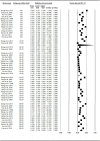The Prevalence of Symptomatic Knee Osteoarthritis in Relation to Age, Sex, Area, Region, and Body Mass Index in China: A Systematic Review and Meta-Analysis
- PMID: 32766258
- PMCID: PMC7378378
- DOI: 10.3389/fmed.2020.00304
The Prevalence of Symptomatic Knee Osteoarthritis in Relation to Age, Sex, Area, Region, and Body Mass Index in China: A Systematic Review and Meta-Analysis
Abstract
Purpose: This study aimed to investigate the overall prevalence of symptomatic knee osteoarthritis (OA) in China by conducting a meta-analysis. Methods: Six databases were searched for articles published from the date of inception to October 1, 2017, based on the Population, Intervention, Comparator, Outcomes (PICO) framework. The review was in line with preferred reporting items for systematic reviews and meta-analyses (PRISMA) guidelines. The χ2-based Q statistic and I 2 metrics were used for exploring the sources of heterogeneity. Random models were utilized to obtain prevalence estimates due to the heterogeneity that was observed. Comprehensive Meta-Analysis version 2.0 was used for assessing publication bias by inspecting funnel plots and Egger's tests. Results: Twenty-one eligible studies (74,908 participants in total) were identified. The overall pooled prevalence of symptomatic knee OA in China was 14.6%. The prevalence of symptomatic knee OA presented a rapid growth trend between the periods of 1990-2008 and 2008-2013 (9.1 vs. 20.1%, p = 0.005). However, after 2013, the prevalence dropped to 14.9% (p = 0.01). The prevalence rates of symptomatic knee OA increased with age and presented an almost linear growth after 40 years of age. Compared with males (10.9%), females (19.1%) exhibited a higher prevalence of symptomatic knee OA (p = 0.015). The symptomatic knee OA prevalence was significantly higher in rural than it was in urban areas (16.9 vs. 11.1%, p = 0.037). Conclusion: For symptomatic knee OA intervention, more attention should be paid to females, people in rural areas, and people aged over 40 years.
Keywords: age; area; osteoarthritis; prevalence; region; sex.
Copyright © 2020 Li, Li, Chen and Xie.
Figures





References
Publication types
LinkOut - more resources
Full Text Sources
Medical

